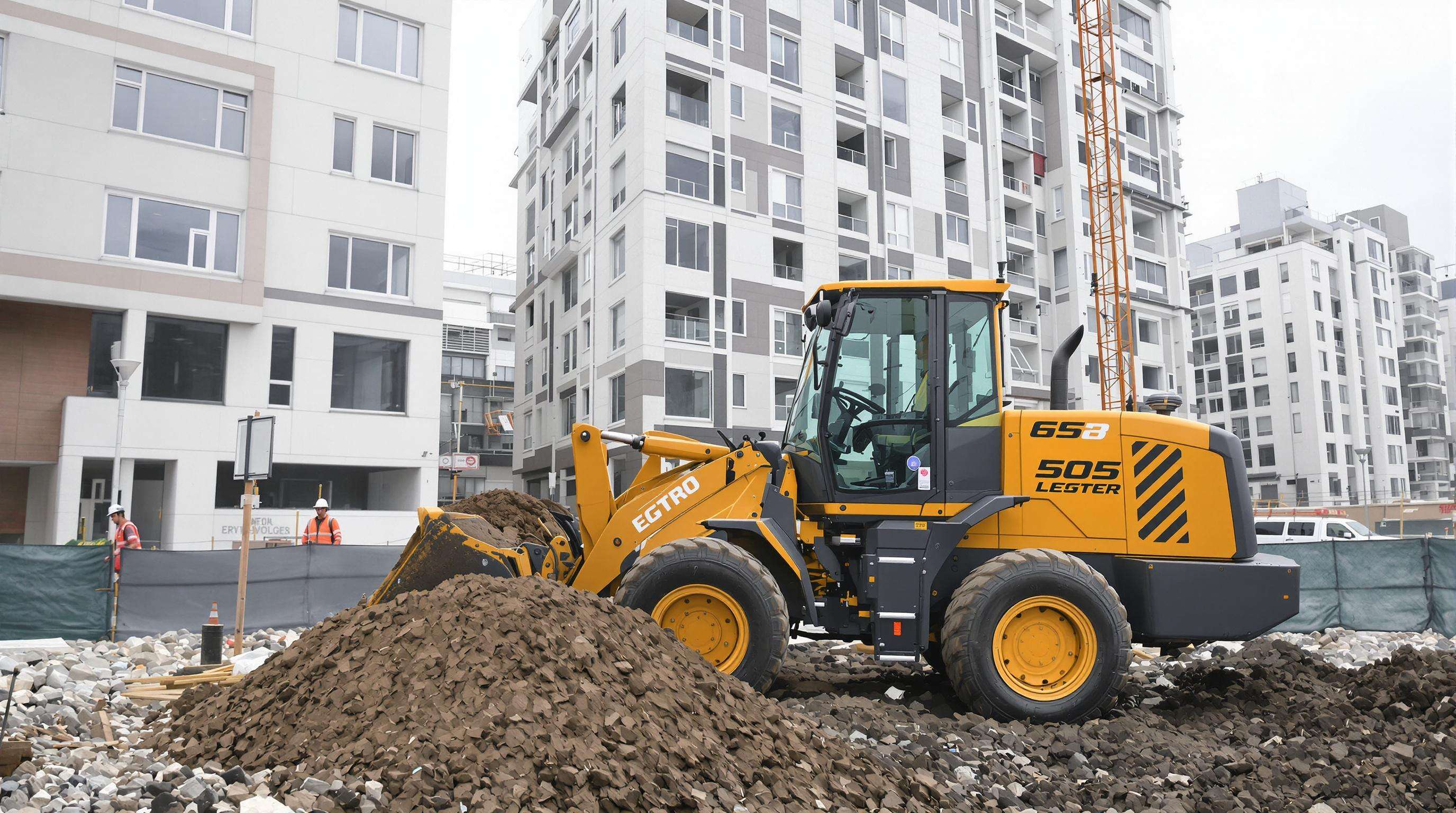The Future of Wheel Loaders in Sustainable Construction
Electrification of Wheel Loaders: Driving the Shift to Zero-Emission Construction

The rise of battery electric wheel loaders in modern construction
Electric wheel loaders running on batteries completely cut out all emissions at construction sites and can save operators anywhere from 30 to 50 percent on operating expenses when compared to their diesel counterparts. Major equipment makers are rolling out electric models ranging between 5 to 8 tons with power outputs sitting around 160 to 200 kilowatts, which is pretty much on par with what traditional machines deliver for city building projects. According to findings published in Nature last year, these electric machines knock out nearly all (about 98%) of the fine particles typically released during operation, although there's still room for improvement in how they capture energy when lowering booms. The European market has been ahead of the curve in adopting this technology, where roughly one in five compact wheel loaders sold in 2024 were electric versions.
Electric vs. hydrogen: Comparing alternative drive systems in heavy machinery
While hydrogen fuel cells offer faster refueling for 10+ ton loaders, electric models dominate due to superior energy efficiency (85% vs. hydrogen's 35–45%) and compatibility with existing infrastructure:
| Factor | Electric | Hydrogen |
|---|---|---|
| Energy Cost/Hour | $9–$12 | $18–$24 |
| Refueling Time | 1–2 hours | 8–12 minutes |
| Cold Weather Range | -25% at -15°C | -8% at -15°C |
Electric systems are better suited for typical 8-hour construction shifts, whereas hydrogen shows potential for continuous operations in mining.
Zero-emission benchmarks and real-world performance of electric wheel loaders
The EU’s 2025 CO₂ reduction mandates align with current electric wheel loader capabilities, supporting 6–8 hours of continuous operation using 350 kWh batteries. Real-world data from fossil-free construction sites shows electric loaders achieve 92% uptime in temperate climates but experience 30% productivity declines in sustained -10°C conditions due to battery derating.
Case study: European pioneers in electric and hybrid wheel loader adoption
Helsinki’s metro expansion replaced 14 diesel loaders with electric models, cutting annual emissions by 740 metric tons—equivalent to removing 160 passenger vehicles. In Oslo, hybrid loaders with swappable battery packs handle 70% of municipal projects, achieving 45-minute turnaround times between 4-hour operational cycles.
Regulatory and Environmental Forces Accelerating Adoption of Electric Wheel Loaders
How Global Emission Standards Are Shaping Wheel Loader Design and Deployment
Tighter environmental rules are pushing manufacturers to completely rethink how wheel loaders work if they want to cut down on pollution. The European Union has set its Stage V standards at just 0.015 grams of diesel particulate matter per kilowatt hour, which is pretty strict. Meanwhile over in California, the CARB regulations require a massive 90 percent drop in nitrogen oxide emissions when compared to those old 2004 standards. All these regulatory changes have really sped things up in the industry. Take a look at what's happening in 2024 markets right now - around one third of all newly released wheel loader models actually come equipped with electric drivetrains instead of traditional engines. Some companies are even developing modular designs that let operators swap out diesel components for electric ones. We've seen this happen already in several cities where municipalities have successfully converted their fleets to meet EPA requirements for cleaner air.
Sustainability Mandates and Their Impact on Construction Equipment Procurement
More and more public works departments and private companies want their equipment to produce fewer emissions when they buy new gear. About two thirds of all infrastructure contracts these days actually require electric or hybrid machines by 2025 at the latest. The push for net zero emissions has really taken off too, causing electric wheel loader sales to jump almost three times what they were last year in early 2025. Cities such as New York City and Toronto are leading the charge with their zero emission zone policies. When looking at the bottom line, procurement managers are starting to see the big picture through lifecycle cost analysis. These studies reveal that while electric loaders cost more upfront, they save around 40 percent on operating expenses over a decade, making them worth the extra cash initially. This move toward cleaner equipment helps fight climate change since construction alone is responsible for roughly one quarter of all carbon dioxide emissions worldwide. Electric wheel loaders can make a real difference in reducing those numbers across the board.
Key Technological Innovations Improving Efficiency and Operational Uptime
Fast-Charging Solutions for Battery-Electric Wheel Loaders: Minimizing Downtime
High-power charging systems can recharge wheel loaders to 80% capacity in under 45 minutes, a 60% improvement over 2020 standards. Advanced thermal management prevents battery degradation during rapid charging, with real-world data showing a 92% reduction in charging-related downtime at mining sites.
Advancements in Energy Efficiency, Durability, and Thermal Management
Regenerative hydraulic systems recover up to 15% of energy during deceleration, while hardened steel alloys extend component lifespans by 30% in abrasive environments. Phase-change materials in battery packs maintain optimal operating temperatures between -20°C and 50°C, addressing cold-weather performance gaps identified in thermal management research.
Challenges in Scaling Electric Fleets on Large Construction Sites
Deploying 10+ electric wheel loaders on a single site presents infrastructure challenges. A 2024 industry report found that 68% of contractors view overnight charging capacity as insufficient for multi-shift operations. Modular battery-swapping stations are emerging as a solution, though widespread adoption requires standardized battery designs across manufacturers.
Market Growth and Automation: The Expanding Role of Autonomous Electric Wheel Loaders
Market Outlook: CAGR and Growth Potential for Electric Wheel Loaders (2023–2030)
Electric wheel loaders are expected to see major growth worldwide by 2030 as governments crack down on emissions and construction companies pledge to reach net-zero targets. Looking at what's happening in the field right now, machines with self-driving features are getting adopted much quicker than anyone predicted. Some contractors who jumped on board early say their projects finished about 35 percent faster because these electric machines don't need breaks for refueling. The price tag still gives pause though. Most equipment owners find that despite the high initial investment, they usually recoup their money back within two to three years when factoring in all those savings from reduced maintenance needs and cheaper electricity bills compared to diesel alternatives.
Autonomous Wheel Loaders in Sustainable Construction: Efficiency and Safety Gains
Autonomous electric wheel loaders enhance safety and efficiency through three key innovations:
- Precision navigation minimizing collision risks with AI-powered obstacle detection
- Optimized load cycles reducing energy waste by 18–22% compared to manual operation
- Predictive maintenance algorithms cutting unplanned downtime by 40%
These advancements position autonomous electric models as essential tools for meeting ESG targets without sacrificing productivity in large-scale infrastructure projects.
FAQ
What are the benefits of electric wheel loaders over diesel ones?
Electric wheel loaders eliminate all emissions at construction sites and can significantly reduce operational costs, saving operators between 30 to 50 percent compared to diesel models.
How do electric and hydrogen wheel loaders compare?
Electric wheel loaders are more energy-efficient with an 85% efficiency rate compared to hydrogen's 35–45%. They are better suited for typical 8-hour construction shifts, while hydrogen loaders offer faster refueling times and potential for continuous operations in mining.
What mandates are affecting the adoption of electric wheel loaders?
Global emission standards, like the EU's Stage V and California's CARB regulations, are prompting manufacturers to adopt more eco-friendly designs. Many infrastructure contracts now require electric or hybrid equipment by 2025.
What technological innovations are enhancing electric wheel loaders?
Advancements such as high-power charging systems, regenerative hydraulic systems, and phase-change materials in batteries have improved energy efficiency, durability, and cold-weather performance of electric wheel loaders.
What is the market outlook for electric wheel loaders?
The global market for electric wheel loaders is expected to grow significantly by 2030 as regulations tighten on emissions, and construction companies aim for net-zero targets.

